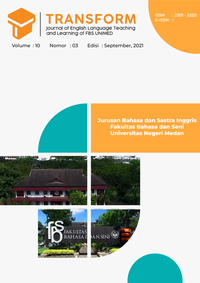Deixis On Mandok Hata In Saur Matua Death Ceremony
DOI:
https://doi.org/10.24114/tj.v10i3.44107Keywords:
Deixis, Mandok Hata, Saur MatuaAbstract
This study dealt with deixis on Mandok Hata in Saur Matua Death Ceremony. The objectives of the study were to identify the deixis types, to evaluate the realization the use of deixis and to explain the reason for using deixis on Mandok Hata in Saur Matua Death Ceremony. This study was conducted by using descriptive qualitative design. The sources of data were taken from VCD of Saur Matua. The technique for analyzing the data is descriptive qualitative research. The results of this research showed that the total numbers of deixis classification were 82. There were person deixis (37.80%), place deixis (1.22%), time deixis (7.32%), discourse deixis (3.66%), and social deixis (50%). The use of social deixis became the most dominant types after person deixis of deixis classification. The realization of deixis found on Mandok Hata in Saur Matua was depend the situation in which language is used that affect both how participants used language and how it is received. The reason why deixis used based on the realization of deixis.Downloads
Published
2023-03-14
Issue
Section
Articles
License
Copyright (c) 2023 Friska Simaremare, Meisuri Meisuri

This work is licensed under a Creative Commons Attribution-ShareAlike 4.0 International License.
Authors who publish with this journal agree with the following terms:
- Authors retain copyright and grant the journal right of first publication with the work simultaneously licensed under a Creative Commons Attribution License that allows others to share the work with an acknowledgment of the work's authorship and initial publication in this journal.
- Authors are able to enter into separate, additional contractual arrangements for the non-exclusive distribution of the journal's published version of the work (e.g., post it to an institutional repository or publish it in a book), with an acknowledgment of its initial publication in this journal.
- Authors are permitted and encouraged to post their work online (e.g., in institutional repositories or on their website) prior to and during the submission process, as it can lead to productive exchanges, as well as earlier and greater citation of published work (See The Effect of Open Access).
- This work is licensed under a Creative Commons Attribution-ShareAlike 4.0 International License.

This work is licensed under a Creative Commons Attribution-NonCommercial-ShareAlike 4.0 International License.



